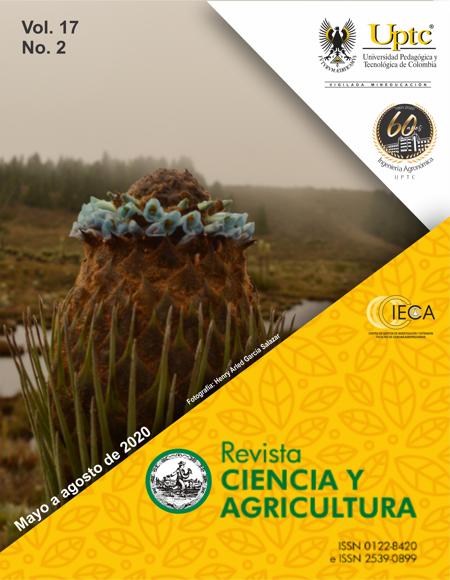Drip Irrigation sheets on Incidence of Prodiplosis longifila (Diptera: Cecidomyiidae) in Tomato (Solanum lycopersicum L.)

Abstract
This investigation sought to determine the effect of four drip irrigation sheets on the incidence of Prodiplosis Longifila in the tomato crop. It was carried out during the dry season from May to September 2018 in La Venturita del Cantón Bolívar, Province of Manabí. Irrigation sheets were studied with variations of evapotranspiration percentage. Treatment 1: drip irrigation sheet at 80% ETc; Treatment 2: drip irrigation sheet at 100% ETc; Treatment 3: drip irrigation sheet at 120% ETc and 78% (Control). A completely randomized design (CRD) was used, with four treatments and six repetitions. The climatic data of evaporation and precipitation were taken daily from the Agrometeorological Station of ESPAM and the electrical conductivity of the soil and water carried out in the INIAP "Pichilingue". With this information the irrigation calculation for the different sheets and phenological stages was made. The results allow determining that with the application of the 100% ETc irrigation sheet, the lowest infestation of P. longifila was recorded accompanied by a rational program of pesticides, with 11 applications of different kind of substances, compared to 30 to 35 applications commonly carried out by farmers.
Keywords
Infestation, Integrated management, drip irrigation, threshold
References
Allen, R., Pereira, L., Raes, D. & Smith, M. (2006). Evapotranspiración del cultivo. Guías para la determinación de los requerimientos de agua de los cultivos. Roma: FAO.
Camborda, F., Castillo, J. & Rodríguez, S. (2015). Trampas de luz con panel pegante para la captura de adultos de Prodiplosis longifila Gagné (Diptera: Cecidomyiidae) en el cultivo de espárrago. Ecología Aplicada, 14(2), 139-145.
Cedano, C. & Cubas, P. (2012). Baeuveria bassiana (Bals)Vuill y Metarhizium anisioplae (Metsch.) Sorokin para el control de pupas de Prodiplosis longifila Gagné en el cultivo de espárrago. Scientia Agropecuaria, 3(1), 29-34.
Chirinos, D. T., Castro, R., Cun, J., Castro, J., Peñarrieta, S., Solís, L. & Geraud, F. (2020). Los insecticidas y el control de plagas agrícolas: la magnitud de su uso en cultivos de algunas provincias de Ecuador. Cienc Tecnol Agropecuaria, 21(1), 1-16. Doi: https://doi.org/10.21930/rcta.vol21_num1_art:1276
Cuzme, B. & Sabando, A. (2005). Efecto de dos sistema de riego y la poda en el manejo integrado de Prodiplosis Longifila (Diptera: Cecidomyiidae) en el cultivo de tomate indeterminado en el valle carrizal Chone. 2004. (Tesis de grado). Escuela Superior Politécnica Agropecuaria de Manabí, Ecuador.
Daza, M., Jurado, J. & Torres, V. (2015). Efecto de aplicación de diferentes láminas de riego en estevia (Stevia rebaudiana bert) bajo invernadero. Temas Agrarios, 20(1), 81-90.
Duque, V., Manzano, M. R. & Rodríguez, E. (2018). Biology of Prodiplosis longifila Gagné and Population Fluctuation in Tomato Crops Sprayed with Insecticides. Revista Facultad Nacional de Agronomía Medellín, 71(1), 8351-8358. Doi: https://dx.doi.org/10.15446/rfna.v71n1.64262
García, C., Vilaró, F. & González, M. (2007). Manejo del riego en el cultivo de tomate industria. Programa Nacional de Producción Hortícola. Revista INIA,12, 26-29.
Goldsmith, J., Castillo, J. & Clarke-Harris, D. (2013). Gall Midges (Cecidomyiidae) Attacking Horticultural Crops in the Caribbean Region and South America. In J. E. Peña (ed.), Potential Invasive Pests of Agricultural Crops (pp. 240-251). Boston: CAB International.
Gonzales, J. (2016). Rendimiento y calidad de tomate (Solanum lycopersicum L. cv. Katya) empleando cuatro láminas de riego bajo condiciones de Cañete. Universidad Nacional Agraria La Molina. Facultad de Agronomía. Departamento Académico de Horticultura. Recuperado de http://repositorio.lamolina.edu.pe/handle/UNALM/2629.
Hernández, L. M., Guzmán, Y.C., Martínez-Arias, A., Manzano, M. R. & Selvaraj, J. J. (2015). The Bud Midge Prodiplosis longifila: Damage Characteristics, Potential Distribution and Presence on a New Crop Host in Colombia. Springerplus, 4, 205. Doi: https://doi.org/10.1186/s40064-015-0987-6
Hernández, L. M., Manzano, M. R., Guzmán, Y. C. & Buhl, P. N. (2018). Parasitoids of Prodiplosis longifila Gagné (Diptera: Cecidomyiidae) and other Cecidomyiidae species in Colombia. Acta Agronómica, 67(1), 184-191. Doi: https://dx.doi.org/10.15446/acag.v67n1.62712
Instituto Nacional de Estadística y Censos –INEC-. (2016). Compendio estadístico 2016. Recuperado de https://www.ecuadorencifras.gob.ec/documentos/web-inec/Bibliotecas/Compendio/Compendio-2016/Compendio%202016%20DIGITAL.pdf
Instituto Nacional de Investigaciones Agropecuarias –INIAP- (2003). Prodiplosis longifila (Díptera: Cecidomyiidae) principal plaga del tomate en Ecuador. Estación Experimental Portoviejo. Proyecto IG CV 028. Ecuador: INIAP.
Jensen, M. E., Burman, R. D. & Allen, R. G. (1990). Evapotranspiration and Irrigation Water Requirements. In Manuals and Reports on Engineering Practice (p. 70). New York: Committee on Irrigation Water Requirements of the Irrigation and Drainage Division of the American Society of Civil Engineers, ASCE.
Lindao, V. A., Jave, J. L., Retuerto, M. G., Erazo, N. S. & Echeverría, M. M. (2017). Impacto en los niveles de colinesterasa en agricultores de tomate (Solanum lycopersicum L.) en la localidad de San Luis, Chimborazo por efecto del uso de insecticidas organofosforados y carbamatos. Revista del Instituto de Investigación FIGMMG-UNMSM, 20(40), 114-119.
Mena, Y. M., Mesa, N. C., Estrada, E. I. & García, Y. (2014). Evaluación de la resistencia a Prodiplosis longifila Gagné (Diptera: Cecidomyiidae) en genotipos de tomate cultivados y silvestres. Acta Agronómica, 63(2), 175-180. Doi: https://dx.doi.org/10.15446/acag.v63n2.30210
Seminis (2018). Registered Trademark of Bayer Group. ©2004-2018. Bayer Group. Recuperado de seminis-andina.com/productos/miramar/368.
Valencia, K. & Proaño, J. (2005). Programación del riego para el cultivo de tomate (Lycopersicum esculentum M.) mediante la tina de evaporación y tres tensiones de humedad del suelo en la zona de Milagro, Provincia del Guayas. En X Congreso Ecuatoriano de la Ciencia del Suelo. Recuperado de http://www.secsuelo.org/wp-content/uploads/2015/06/10.-Programacion-del-Riego.pdf
Valarezo, O., Cañarte, E., Arias, M., Proaño, J., Navarrete, B., Garzón, A., Jines, A., Cuadros, A., Porro, M., Linzán, L. & Chávez, J. (2003). Diagnóstico, bioecología y manejo sostenible de la negrita Prodiplosis longifila en el Ecuador. Ecuador: Instituto Nacional Autónomo de Investigaciones Agropecuarias INIAP.
Valarezo, O., Cañarte, E., Navarrete, B., Guerrero, J. M. & Arias, B. (2008). Diagnóstico de la “mosca blanca” en Ecuador. La Granja (Ecuador), 7(1), 13-20.